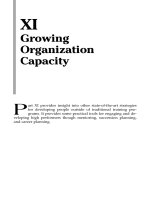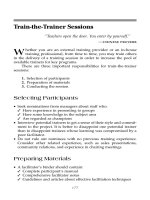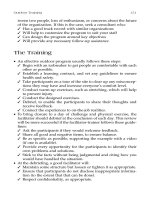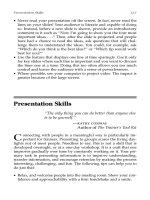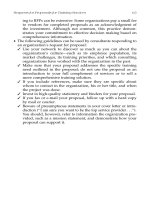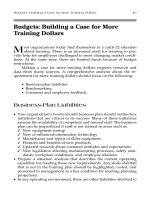The Trainer’s Tool Kit Second Edition phần 10 pptx
Bạn đang xem bản rút gọn của tài liệu. Xem và tải ngay bản đầy đủ của tài liệu tại đây (434.66 KB, 30 trang )
XI
Growing
Organization
Capacity
P
art XI provides insight into other state-of-the-art strategies
for developing people outside of traditional training pro-
grams. It provides some practical tools for engaging and de-
veloping high performers though mentoring, succession planning,
and career planning.
PAGE 201
10916$ PT11 10-21-04 07:58:37 PS
This page intentionally left blank
Mentoring Best Practices
‘‘In training we try to make people fit better.
With mentoring, we try to make fit people even
better.’’
—kathy conway
Author of The Trainer’s Tool Kit
M
entoring is a customized development opportunity whereby an
employee has access to the perspective and wisdom of a more
seasoned employee. This partnership facilitates the ability of the
mentee to contribute to the organization. A facilitated program typi-
cally links people who may not normally interact.
The advantage of implementing a mentoring program today is
that we gain insight by researching what other organizations have
done well. Here are some lessons learned.
• Mentoring works best when:
✓ Organizations define what they expect from a mentoring pro-
gram.
✓ Organizations acknowledge that informal mentoring already
goes on (thereby including, rather than excluding, those practic-
ing it successfully).
✓ Organizations create partnerships or employees with different,
not similar, functional expertise (thereby not duplicating or
jeopardizing manager-employee relationships).
✓ Mentoring is targeted at high-performing individuals; it is not a
remedial initiative.
✓ Mentoring supports a career-development ethic that encourages
the individual to manage his or her own career.
✓ Mentees work hard on setting goals and taking equal responsi-
bility for the success of the relationship.
✓ Mentors view the process as an opportunity to practice and en-
hance leadership skills.
✓ Mentors and mentees set up their own networking forums with
each other to exchange ideas and successes.
✓ Mentors gain something from the partnership—for example, en-
hanced leadership skills.
PAGE 203
203
10916$ CH11 10-21-04 08:01:11 PS
204 Growing Organization Capacity
✓ There is an administrative infrastructure and someone who
‘‘checks in’’ on the progress of the relationship and is able to
intervene if the process is not productive.
✓ There is clear differentiation between reporting relationships
and mentoring relationships.
✓ The organization provides lots of tools, but encourages creativ-
ity and individuality in partnerships.
✓ Mentees don’t expect promotions as an outcome; instead, parti-
cipants will be more motivated to personalize development and
explore more options.
✓ Participants expect the partnership to have highs and lows, and
have contingency plans for the low time.
The following important shifts are from previous years:
Old Style New Style
Mentors can aid the mentee best Mentees grow best by partnering
when the mentee has similar per- with someone with a different
ceptions about the organization. perspective or career path.
Mentoring partners are most ef- Mentoring partners gain when
fective when they work in the they focus on common organiza-
same functional area. tional skills for success, not func-
tional expertise.
Mentors measure mentees’ suc- Mentors measure mentees’ suc-
cess by their advancement within cess by their attachment to the or-
the organization. ganization.
Mentoring partnerships rely on Mentoring partnerships rely on
effective two-way interpersonal effective two-way respect and
chemistry. commitment.
Mentors help mentees to become Mentors help motivated people
more motivated. to become more effective.
Mentors have been consistently Mentors can provide insight on
successful in their careers. successes and failures—and
allow mentees to learn from
both.
PAGE 204
10916$ CH11 10-21-04 08:01:11 PS
205Mentoring Best Practices
Mentors coach mentees for out- Mentors coach mentees for oppor-
comes. tunities.
Mentors rely on their own expe- Mentors rely on their network to
rience and expertise to help men- help mentees.
tees.
Questions to Determine if Your Organization’s Program Is Likely to
be Successful
• Is leadership development an important component of the organi-
zational strategy? Yes No
• Do you have a career self-management ethic that emphasizes indi-
vidual accountability? Yes No
• Are self-service learning tools available (including tuition reim-
bursement)? Yes No
• Is accountability for employee performance a shared responsibility
between HR and the senior team? Yes No
• Are coaching and feedback integral to a manager’s job?
Ye s N o
• Is staff retention a priority? Yes No
• Have common skills for success been identified (that is, core com-
petencies, success dimensions, and so forth)? Yes No
• Are there some recognized role models and informal mentors
within the organization? Yes No
• Would leaders and managers themselves benefit from practicing
and demonstrating leadership by becoming formal mentors?
Ye s N o
• Do you have the resources to train mentors and mentees prior to
their involvement in the process? Yes No
Not all answers need to be yes; however, too few yes answers
may indicate a need to reinforce some elements of your people-
PAGE 205
10916$ CH11 10-21-04 08:01:11 PS
206 Growing Organization Capacity
development strategy concurrent with the introduction of a mentor-
ing program.
Implementing a Mentoring Program
‘‘Success breeds success.’’
—unknown
M
entoring programs are a powerful strategy for developing tal-
ent by encouraging individuals to take responsibility for their
long-term development. At the same time, mentors can increase their
coaching, feedback, and leadership skills. The organization also bene-
fits from more motivated, competent employees, less turnover, in-
creased confidence and enthusiasm. In a nutshell, everyone benefits.
• The following guidelines were suggested by organizations that
have implemented successful mentoring programs:
✓ Set budget guidelines for the program since there will be costs
for orientation sessions, self-assessment guides, and program
publicity. Include the hidden costs of a program (for example,
time off the job or travel costs).
✓ Determine who can participate in the program as mentors and
mentees, and the length of the program.
✓ Decide whether the relationships will be one-on-one or involve
more than one mentee per mentor.
✓ Consider how the matching will be done after researching suc-
cessful mentoring programs.
✓ Set time limits for evaluating results. Experience suggests that
one year is the optimum time frame for evaluating results.
✓ Mentors should be at least two levels higher than a mentee so
mentees have the advantage of senior perspective.
✓ Develop a workbook or seminar that allows mentees to do a
comprehensive self-assessment about goals, as well as their indi-
vidual strengths and weaknesses.
PAGE 206
10916$ CH11 10-21-04 08:01:12 PS
207Implementing a Mentoring Program
✓ Provide the mentor and mentee with the tools to be able to es-
tablish an effective working relationship. This ‘‘contract’’ will
include items such as:
• Openness and honesty
• A process for evaluation
• Do’s and don’ts during meetings
• Confidentiality
• Goals and objectives
• Issues that will be off limits
• Reasons for postponing or canceling meetings
• Times, places, and frequency of meetings
• Determine appropriate recognition and incentives for mentors (for
example, a Mentor of the Year award).
• Provide forums for mentors to meet with each other for sharing
suggestions and successes. Do the same for mentees.
• Be sure to publicize successes and outcomes to keep the momen-
tum strong.
• Recruit your highest potential performers as mentees. These are
people who can do the following:
✓ Become a full partner in the relationship with the mentor.
✓ Establish a small number of long-term goals that are specific,
measurable, achievable, realistic, and time based.
✓ Develop a plan to achieve long-term goals and dates by when
they will be complete.
✓ Make a public commitment to their goals, so that others can
monitor and encourage the mentee.
✓ Take ownership for goal achievement.
✓ Relish the opportunity to learn from others.
✓ Do one thing each day that will take them closer to their goal.
✓ Set goals that are important to them, as much as they may please
others.
✓ Treat failure as an opportunity to learn.
✓ Keep track of the most important lessons learned so that they
can be referred to in order to reinforce continuous learning.
✓ Learn to listen to and accept negative feedback as an opportu-
nity to learn.
✓ Keep their goals in front of them constantly—for example,
posted on a mirror at home or in a desk drawer.
✓ Approach each day with a sense of discovery.
✓ Take more risks.
PAGE 207
10916$ CH11 10-21-04 08:01:12 PS
208 Growing Organization Capacity
✓ Keep a list of things that it would be good to learn within five,
ten, and twenty years.
• Mentors can contribute to the development process in many differ-
ent ways, including:
✓ Allowing the mentee to observe senior management meetings
✓ Taking the mentee to professional networking meetings
✓ Reviewing the mentees’ re
´
sume
´
for critical comment
✓ Passing on topical articles and books for comment
✓ Discussing the impact of their own role models and mentors
✓ Passing on invitations to professional-development events such
as breakfast meetings and product launches
• Mentoring meetings are most successful when they follow a set
format:
✓ Updates on action items
✓ Debriefing on problematic assignments since the last meeting
✓ Feedback by the mentor on his or her observations of the mentee
in action
✓ Suggestion for development initiatives, including reading and
industry events
✓ Opportunity for the mentee to share success stories
✓ Mutual ‘‘homework’’ assignments that cover both research and
action items
• Regular meetings between mentor and mentee will be productive
if:
✓ There is a focus on one area of development.
✓ The meeting ends with ‘‘homework’’ assignments, and these are
documented. The assignments are specific, with timelines and
methods agreed upon.
✓ Both sides practice careful listening.
✓ Time restrictions are honored.
PAGE 208
10916$ CH11 10-21-04 08:01:12 PS
209Training and Orientation for Mentors and Mentees
Training and Orientation for Mentors
and Mentees
‘‘There’s always room at the top.’’
—daniel webster
Statesman, Lawyer, and Orator
A
n orientation training session is an important step in launching
successful partnerships. These sessions create opportunities to
probe expectations, including potential challenges, review organiza-
tional support for the program, and establish a network for partici-
pants.
• Sessions are typically held separately for mentors and mentees, as
each group may feel constrained in asking questions in front of
their potential partners. Separate sessions will also reinforce the
networking and learning opportunities that each group has for
sharing suggestions and techniques. Effective orientation sessions
combine elements of:
✓ Information
✓ Advice from others
✓ Practice exercises and case studies
✓ Workbooks and guidelines
✓ Sufficient time for questions and answers
• Here are some recommended components of mentoring orientation
sessions (which are often summarized in a workbook or tool kit):
Organizational Support
✓ How the organization defines mentoring and its expected out-
comes
✓ Program facilitator and his/her roles and responsibilities, includ-
ing trouble-shooting
✓ Additional resources available (for example, communication-skills
classes, names of previous participants, or self-assessment tools)
✓ Success measures both for the program and for individual partner-
ships
PAGE 209
10916$ CH11 10-21-04 08:01:13 PS
210 Growing Organization Capacity
✓ Anticipated time commitments for meetings and other related ac-
tivities (including guidelines for investing one’s personal time)
✓ Scheduled check-ins and networking events to assess how partner-
ships are proceeding
Partnership Dynamics
✓ How participants were chosen
✓ How partners are matched
✓ Anticipated common outcomes balanced with partnerships’ inde-
pendence to set individual operating guidelines
✓ Partnership agreements that include discussions and commitments
about confidentiality, honoring time commitments, learning styles,
and personal expectations
✓ Addressing potential partnership breakdowns, including trouble-
shooting and replacing partnerships required (for example, trans-
fers or overwhelming time commitments)
✓ How to be a responsible partner
✓ Concluding the partnership
Advice from Others
✓ Do’s and don’ts from other organizations
✓ Advice from previous participants
✓ ‘‘Best practices’’ research
✓ Recommended reading, including articles
✓ Suggestions from recognized role models and mentors within the
organization
Goal Setting
✓ How to set personal development expectations (for example, feed-
back or career self-management steps)
✓ Setting realistic expectations
✓ Roles and responsibilities within the partnership for goal setting
✓ Elements of a personal development plan
✓ Setting personal benchmarks for success
✓ Identifying potential activities that can support mentee goals (for
example, internal meetings, networking groups, committee work,
or related courses)
PAGE 210
10916$ CH11 10-21-04 08:01:13 PS
211Career Planning Programs
✓ Recalibrating goals as required
✓ Celebrating success
Communication Skills and Techniques
✓ Effective questioning skills
✓ Effective listening skills
✓ Seeking feedback
✓ Giving feedback
✓ Probing assumptions and observations
✓ Collaborative decision making and brainstorming techniques
✓ Personal style assessments
✓ Networking dynamics
Program Conclusion
✓ Summarizing outcomes
✓ Acknowledging a partner’s contribution
✓ Feedback to the organization
✓ Personal action plan development
✓ Guidelines for keeping in touch with a partner
✓ Applying lessons learned on the job
Career Planning Programs
T
he training investment that organizations make is maximized
when employees can link their own goals to business goals.
• Career development for employees in an organization can take
many forms:
✓ Increased responsibility and enhanced skill sets in a current job
✓ A lateral move to another position
✓ Advancement to a higher level
✓ Long-term planning for a career change
PAGE 211
10916$ CH11 10-21-04 08:01:13 PS
212 Growing Organization Capacity
✓ Reduced responsibilities for lifestyle priorities
✓ Retraining for new and emerging occupations
• Organizations that establish a clear relationship between training
and career development enjoy the following benefits:
✓ A competitive advantage in attracting new employees
✓ A better ability to retain employees
✓ Increased employee morale and motivation
✓ Meaningful succession planning
✓ Business plans that identify realistic objectives for employee de-
velopment
• Here are some of the most common ways organizations promote
individual responsibility for career planning:
✓ The provision of standardized career planning seminars avail-
able to all employees—either mandatory or voluntary atten-
dance, during or outside normal business hours
✓ Career planning workbooks for use during seminars or as stand-
alone aids
✓ Self-help books, videos, or computer-based tools for self-
directed study
✓ The establishment of a formal mentor program with clear roles
and responsibilities for both mentors and mentees
• An effective career planning seminar, workbook, or computer-
based training aid should address the following elements:
✓ Emphasis on individual accountability for career management
✓ Up-to-date information about the competitive marketplace and
the customer base
✓ Self-assessment exercises about skills and personal preferences
✓ Personal marketing techniques
✓ Information-gathering techniques
✓ Developing mentor relationships
✓ Comprehensive information about in-house training
✓ The relationship of continuous learning to corporate objectives
✓ The importance of identifying hidden success factors: adapting
to change, coping with stress, and helping others be successful
✓ Cost-effectiveness
✓ Accessibility for all employees, including employees at different
geographic locations and those who work shifts
• Career planning programs work best when:
✓ Senior management supports the program.
PAGE 212
10916$ CH11 10-21-04 08:01:14 PS
213Promoting Career Self-Management
✓ There is a role for managers to support and reinforce the objec-
tives of the program.
✓ There are self-study tools for employees to use for their personal
development and growth.
Promoting Career Self-Management
T
he days of organizations throwing money at training are over.
So too are the days when a manager took responsibility for the
careers of his or her staff. Today, employees need to be proactive in
taking charge of their learning and careers. They are the senior part-
ners and their manager is the guide and facilitator.
• Visible support for individual career planning initiatives is becom-
ing an increasingly important component of an organization’s
training strategy because it:
✓ Facilitates the process whereby individuals translate self-discovery
into meaningful development activities
✓ Equips individuals to be proactive in finding ways to utilize
skills gained from training courses
✓ Encourages individuals to link their strengths and interests to
real and potential opportunities
• An organization can support a career self-management culture in
many ways, including the following:
✓ Assigning clear roles and responsibilities for managers, employ-
ees, and the senior team to support development
✓ Providing facilitated sessions for voluntary employee participa-
tion
✓ Providing a variety of self-assessment tools and resources
✓ Training and coaching managers to be career development ad-
vocates for their staff
✓ Seeking input from employees about barriers to effective self-
development and addressing these barriers
PAGE 213
10916$ CH11 10-21-04 08:01:14 PS
214 Growing Organization Capacity
✓ Providing guidelines for individual development contracts be-
tween managers and employees
✓ Encouraging informational interviews as a learning tool and de-
veloping guidelines for conducting them
✓ Posting inventories of assignments and opportunities for inter-
ested employees to learn or practice new skills
✓ Posting lists of subject-matter experts within the organization
who are available for some one-on-one coaching
✓ Convening panels of leaders who describe their own career deci-
sions and related activities
✓ Advertising all informal training with the organization, includ-
ing ‘‘lunch and learns’’
✓ Holding ‘‘open houses’’ in various departments to discuss job
content and qualifications
✓ Maintaining up-to-date lists of job specifications and experience
requirements that employees can access
✓ Holding open forums periodically to talk about what an organi-
zation will look like, and need, in a three- to five-year view
✓ Recognizing and rewarding effective coaches, role models, and
mentors
✓ Linking mentoring opportunities to pending skills shortages
✓ Creating mentoring opportunities for those who have taken the
initiative in personal career self-management
✓ Providing multiple examples of what core competencies ‘‘look’’
like in everyday practice, together with practical suggestions for
activities that develop them
✓ Linking training courses to specific positions and roles within
the organization by listing these in course descriptions
✓ Canvassing participants in career planning sessions for sugges-
tions for a training course curriculum
✓ Developing a Q&A on the organization’s intranet for practical
career planning advice
✓ Equipping employees with skills that support career self-
management—for example, seeking feedback, conducting re-
search, and effective networking
PAGE 214
10916$ CH11 10-21-04 08:01:14 PS
215Succession Planning
Succession Planning
D
ownsizing, rightsizing, and reengineering have all had a devas-
tating impact on the number of middle managers now available
to step up to the plate and replace top managers as they come due
for retirement. Succession planning helps to replace the talent that
has dwindled following layoffs, resignations, transfers, or promo-
tions. At the same time, it will grow the pool of people interested in
other opportunities.
• There are seven important steps in creating effective succession:
1. Identify the key corporate positions that are fundamental to the
organization’s success.
2. Nominate high-performing individuals as potential successors.
This is often done through succession planning committees with
senior representatives of line functions, human resources staff,
and training professionals.
3. Assess key gaps in successors’ skills to meet current and future
requirements.
4. Develop a comprehensive training strategy for successors that
encompasses both formal and informal training.
5. Identify and evaluate the training courses and options available
that best suit your specific requirements.
6. Calculate the costs of succession training and create a budget.
7. Implement the succession-training plan by identifying key
steps, deadlines, and measurement criteria.
• Important steps to develop successors include:
Assess Key Gaps in Successors’ Skills
✓ Interview incumbents of key corporate positions to understand:
• Their background and training
• Their assessment of future skill requirements
• The timeliness of developing effective successors
• Their recommendations for effective successor training
• Their availability to act as coaches and mentors to successors
• Their assessment of successors’ strengths and weaknesses
✓ Interview identified successors to understand their:
PAGE 215
10916$ CH11 10-21-04 08:01:15 PS
216 Growing Organization Capacity
• Training and experience
• Self-assessment of skills needed in a more senior job
• Availability for long-term training
• Recommendations for effective succession training
• Short-term professional development plans
Identify Skills Gaps Under These Headings
✓ Business skills
✓ Industry-specific skills
✓ Management skills
• Prioritize the importance of the skill gaps.
• Secure agreement with incumbents and successors about time
frames to address skill gaps.
Determine the Best Training Vehicle to Meet Skill Gaps
✓ Formal training
✓ On-the-job training
✓ Internal courses
✓ External courses
✓ Professional upgrading
✓ Job rotation
✓ Job shadowing
✓ Computer-based training
✓ Subscriptions to professional journals
✓ Task assignment to task forces
✓ Special projects
✓ Formal coaching or mentor contracts
✓ Educational upgrading
✓ Interorganizational exchange programs
Identify and Evaluate Training Courses for Successors
✓ Consult the in-house training catalog for available courses.
✓ Determine prices, availability, and waiting lists for external
courses.
✓ Check references for external courses by contacting previous at-
tendees.
✓ Develop ‘‘learning contracts’’ for informal training, coaching, or
mentoring relationships.
PAGE 216
10916$ CH11 10-21-04 08:01:15 PS
217Succession Planning
✓ Ensure that succession candidates meet prerequisites for external
courses, university programs, or professional upgrading.
✓ Consider a customized in-house program for succession candi-
dates with common skill gaps.
Calculate Costs and Create a Budget
A budget for succession training includes:
✓ Course costs
✓ Travel and accommodation costs for out-of-town courses
✓ Subscriptions to professional journals
✓ Specialized equipment needs (for example, CD-ROM, Internet ac-
cess, or interactive video learning facilities)
✓ The costs of time off the job
Implement the Succession Training Strategy
✓ Set deadlines for training that addresses high-priority gaps.
✓ Review the training plan annually to ensure it continues to meet
business needs.
✓ Adapt the plan annually to meet new and emerging corporate pri-
orities.
✓ Confirm budget approval for succession training costs annually.
This is particularly important for long-term strategies.
✓ Set formal feedback guidelines for coaches and mentors to monitor
progress and make recommendations.
✓ Create opportunities for succession candidates to practice and im-
plement new skills.
✓ Keep abreast of new courses and lower-cost training options, and
amend the training plan accordingly.
✓ Involve succession candidates in realistic self-assessment exercises
after each important training component.
✓ Determine key learning outcomes for each training component,
and monitor these outcomes rigorously.
PAGE 217
10916$ CH11 10-21-04 08:01:15 PS
218 Growing Organization Capacity
Designing an In-House Succession
Program
H
aving a succession plan that is always current sends a signal
to all would-be leaders that the organization is serious about
maintaining the strength of its talent. An organization that plans for
staff development will more than likely retain staff longer.
• Many organizations typically outsource the leadership develop-
ment of the senior talent pool to established executive preparation
programs at universities and other institutions. There are some dis-
advantages to this strategy:
✓ These programs are typically expensive, often costing $10,000 or
more.
✓ The programs are not customized to your unique operating en-
vironment.
✓ The programs cover a broad range of topics—not all of which
are targeted to your candidate’s or your organization’s needs.
✓ The learning is condensed into a short period of time.
✓ There is no real opportunity for your candidate to practice
newly acquired skills in case studies that reflect his or her work-
place.
✓ It is difficult for a candidate’s manager to debrief the candidate
after the program to set up a learning action plan.
✓ There is the risk that recruiters will target your candidate for job
search opportunities.
• To create realistic learning plan for a senior talent pool, consider
the following:
✓ Establishing a time frame for the learning experience—for exam-
ple, twelve months
✓ Establishing criteria for inclusion in the pool (for example, exec-
utive recommendation, performance and evaluation results, or
candidate interest)
✓ Designating key executive champions who will implement the
strategy and monitor results
✓ Determining realistic outcomes (for example, four or five candi-
dates who can assume greater responsibility after twelve months)
PAGE 218
10916$ CH11 10-21-04 08:01:15 PS
219Designing an In-House Succession Program
• Recommended learning activities for potential leaders include:
✓ Competitive Intelligence. Assign groups of three or four candi-
dates to assess the strengths and weaknesses of some key com-
petitors. Set a deadline for presentations to the senior team—for
example, two months. The senior team will provide feedback
and comments after each presentation.
Outcomes
• Teamwork dynamics
• Presentation experience at the senior level
• Opportunity to gain feedback from the senior team
• Opportunity to probe and understand the competitive land-
scape
• Experience in research and analysis techniques
✓ Brainstorming and Problem Solving. Select three or four issues
unique to your organization for the candidate pool to discuss and
offer recommendations. Create an ongoing forum for the pool to
meet with the senior executive for an effective exchange of ideas
and solutions. These issues may be business-based or human re-
sources based—for example, morale.
Outcomes
• Experience in interacting with senior team and/or senior ex-
ecutive that is atypical of normal meetings
• Generates creative thinking and risk taking
• Creates confidence in making recommendations and demon-
strating reasoning and logic
• Encourages effective listening and feedback when discussing
ideas with others
✓ Executive Book Club. Participants each design a reading list for
themselves around key leadership and practical business issues by
reading reviews of topical business books. Participants then pre-
pare short summaries of books read for distribution to the execu-
tive team and the other participants. Participants and the senior
team meet occasionally to discuss some key information from cur-
rent books and assess their applicability to the organization.
PAGE 219
10916$ CH11 10-21-04 08:01:16 PS
220 Growing Organization Capacity
Outcomes
• Participants and the executive team keep abreast of current or-
ganizational literature and engender an ongoing reading culture
• Participants develop an ability to assess a significant amount
of data and identifying key points
• Improved presentation skills
✓ Meeting with a Role Model. Each participant identifies a business
leader with whom he or she would like to meet. This involves
research and reflection by each participant and emphasizes the
importance of success models in sustaining high performance. The
executive team utilizes its networks and contacts to arrange these
meetings.
Outcomes
• The executive team will have put their combined networks to
use and will have created a unique retention strategy by facili-
tating these meetings.
• Participants will learn to create an agenda for this meeting to
maximize time and information.
• Participants will have gained both energy and insight from
these individual meetings and an opportunity to present an
overview to others in the organization.
• There are many other opportunities for creating a learning curricu-
lum to meet succession needs—for example, mentoring or commu-
nity service—together with your established training courses. The
following benefits come from creating an in-house program:
✓ The senior team has an opportunity to see candidates regularly
and influence their development.
✓ The senior team can take advantage of the specialized research
candidates complete and recommendations presented.
✓ The talent pool establishes networks that may not occur natu-
rally.
✓ The candidates’ commitment to the organization strengthens as
they see a bigger picture of the real business of the organization.
✓ Time commitments and expenses are reduced significantly.
✓ It will be easier to monitor those staff members who embrace
this opportunity to learn as compared with those that consider
new learning as a waste of time.
PAGE 220
10916$ CH11 10-21-04 08:01:16 PS
221Ten Ways to Take the ‘‘Success’’ out of Succession Planning
Ten Ways to Take the ‘‘Success’’ out of
Succession Planning
E
xecutives and employees alike often disparage the lack of visible
and effective results in the organization’s succession planning
process. This holds true whether the process is formal or casual,
highly transparent or secretive.
The following ten common mistakes can undermine results:
1. Delegating Full Responsibility to Human Resources. The ex-
ecutive team is ultimately responsible to all stakeholders for
the ongoing health of the organization. HR can be a facilita-
tor, providing intelligence about best practices and employee
skills and interests, but it cannot commit the organization’s
resources to the task, nor assess the emerging business chal-
lenges that create successor profiles.
2. Focusing Only on the Senior Team. A senior team is mobile
by definition, as its members are highly visible to competi-
tors. Realistic plans must also include key groups and posi-
tions that are fundamental to your success and not easily
replaced internally or accessed on the open market. These
positions may be buried deep in the classification structure,
but are no less critical to continuing success.
3. Replacing People, Rather Than Developing Them. A plan
that simply identifies drop-dead successors typically over-
looks the broader talent base available and may not be ad-
dressing fundamental changes in the competitive landscape.
It is important to invest in all high performers who have the
opportunity to grow organizational capacity.
4. Not Consulting with Potential Successors. More that a few
organizations have been shocked when a top succession can-
didate has left the organization for a better opportunity,
completely unaware of the plans for him or her. It’s vital that
succession candidates have an opportunity to discuss their
development interest and goals to create a realistic action
plan that excites them.
PAGE 221
10916$ CH11 10-21-04 08:01:16 PS
222 Growing Organization Capacity
5. Identifying Successors at Every Level. A master chart that
identifies likely successors for too many positions and levels
within the organization drains energy from an organization.
Employees need to feel some organizational ‘‘breathing
space’’ to grow skills and to be recognized for future oppor-
tunities.
6. Making Assumptions. Not all people equipped to advance to
the next level actually want to do so. Not all key jobs are
fully understood by potential successors. Success depends
on frank conversations as much as on detailed skill profiles.
7. Not Updating Plans Regularly. An annual plan typically
doesn’treflect ongoing intelligence about business dynamics
and employee achievements. Refine the plans as often as a
senior team meets.
8. Relying Exclusively on an Incumbent’s Perspective. An in-
cumbent is one of many who should scope out position re-
quirements and a successor profile. Internal and external
clients, direct reports, and the senior team all have important
insights about creating this profile.
9. Outsourcing Successor Development. Successor develop-
ment cannot be done wholly off-site. The key ingredients of
a plan involve internal exposure and experience, direct client
contact, industry events and mentoring by key decision mak-
ers and role models. External courses can supplement, but
not replace, your unique requirements.
10. Calling the Recruiters Too Late. The time to place a call for a
key search is well in advance of a vacancy. Develop ongoing
relationships with recruiters that specify target organizations
and identify unique skills and emerging needs. Create op-
portunities for recruiters to understand your business
thoroughly. Your search, when activated, will be more com-
prehensive.
PAGE 222
10916$ CH11 10-21-04 08:01:17 PS
223Energizing High Performers Through Training and Learning
Energizing High Performers Through
Training and Learning Opportunities
T
oo often, the target audiences for training courses and limited
training dollars are employees who underperform. Overlooked,
often, are the loyal and skilled employees responsible for an organi-
zation’s past and continuing success. It is important to invest in their
continuing development and morale, as it is their energy and attitude
that set the standards for others.
Here are some guidelines for creating informal learning opportu-
nities that engage high-performing employees and expand their im-
pact in the workplace:
• Through discussion, find out what achievements an employee is
proud of and what assignments he or she has found most satisfy-
ing. Use the information to create new assignments that bring a
balance of risk and energy to his/her role. We often know what
employees have done, but not what they love to do! This allows
an employee to practice his or her strengths in new or unusual
circumstances.
Examples of Assignments
✓ An external assignment or exchange
✓ An opportunity to represent the organization within the commu-
nity—for example, service club, schools, or industry associations
✓ Coordinating a conference for customers or a business unit
✓ Participation in hiring and recruitment
• Utilize the organization’s networks and profile to create an oppor-
tunity for the employee to serve in a high-profile or executive role
in an industry or professional association. Performers gain en-
hanced networks as well as the opportunity to develop influencing
and leadership skills.
Examples of External Organizations
✓ Charitable organizations that the organization supports
✓ Advisory boards for specific courses at colleges and universities
PAGE 223
10916$ CH11 10-21-04 08:01:17 PS
224 Growing Organization Capacity
✓ Civic organizations and service clubs
✓ Bodies that set industry standards
✓ Consumer groups linked to your industry
• Learn more about the employee’s business role models and others
he or she would enjoy meeting. Set up meetings for the employee
with as many people as possible or facilitate a mentoring partner-
ship. The employee gets interaction skills as well as valuable in-
sights, which he or she can subsequently communicate to others.
Examples of Role Models
✓ Senior executives
✓ Key customers
✓ Retired executives
✓ Stock analysts and business writers
✓ University faculty members
✓ Local government leaders
• Personalize a training opportunity for the employee by sending
him or her to a unique course that develops a specific interest area
not normally offered through a traditional training curriculum.
These courses are energizing for an employee and typically can
create opportunities for the employee to present short presenta-
tions to others after the course that sharpen training and delivery
skills.
Examples of Unique Courses
✓ Comedy workshops
✓ Specialized cooking courses
✓ Motivational speakers
✓ Arts and crafts
✓ Home repair and decorating
✓ Personal effectiveness skills (for example, speaking, writing, or
managing time)
✓ Managing difficult people
• Establish a personal board of directors for an employee to review
his or her personal career planning and development action plan.
Draw on a variety of senior personnel to give pragmatic feedback
PAGE 224
10916$ CH11 10-21-04 08:01:17 PS
225Energizing High Performers Through Training and Learning
and practical advice for longer-term development. This team can
meet two or three times in a year to track development activities
and create customized learning opportunities.
Examples of Advisory Meeting Topics
✓ Self-directed learning materials, including current business books
✓ Creating and sustaining networks
✓ Accessing a senior-level mentor
✓ Gathering meaningful feedback
✓ Setting goals, timelines, and measurements in a personal develop-
ment planning process
✓ Balancing home and work
• There are many other learning opportunities that can be personally
rewarding for high performers and use few training dollars. After
the employee has completed a learning assignment, be sure to de-
brief the employee about new skills acquisition and create an action
plan for expanding these skills in his or her ongoing role.
PAGE 225
10916$ CH11 10-21-04 08:01:17 PS

